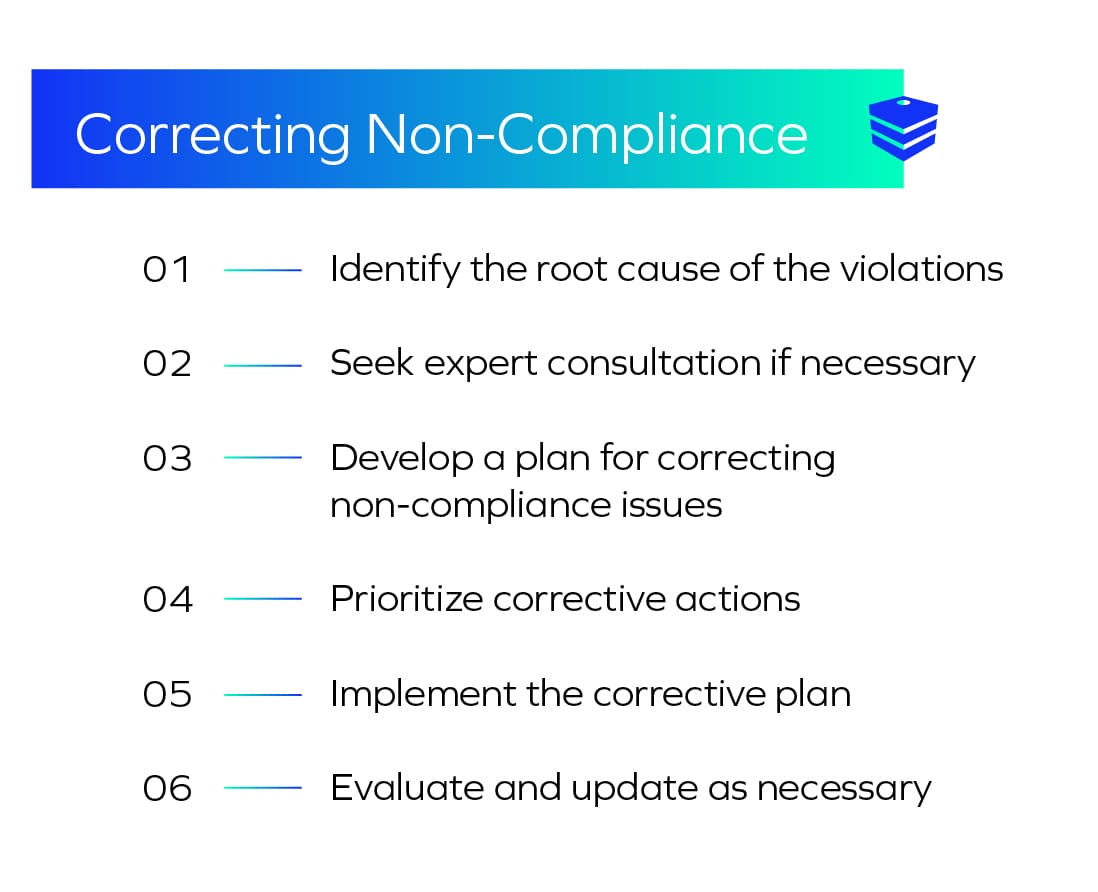Compliance Services
How to Correct Regulatory Non-Compliance (And the Consequences for Not Doing So!)
April 09, 2024
8 minute read

As cyberattacks become more prevalent and more sophisticated, more industries than ever before are establishing standard data privacy regulations that organizations must follow. These regulations follow in the footsteps of other well-established industry regulations, like HIPAA, for example.
The main purpose behind these regulations is to standardize how organizations collect, store, use, and protect customer data.
Sign up for our newsletter!
However, this also means that businesses have a responsibility to adhere to newly established industry regulations and correct instances of non-compliance. Here’s how you can address non-compliance corrections within your organization using a systematic approach.
If you’re worried about adhering to industry regulations and don’t feel comfortable establishing data privacy protocols yourself, consider working with DOT Security to ensure compliance both now and in the future.
Correcting Non-Compliance Step by Step
Navigating the intricate maze of regulatory requirements can often feel like traversing uncharted territory for organizations across industries. Despite diligent efforts to maintain compliance, the occasional violation is somewhat inevitable.
However, the true test of organizational resilience lies not in avoiding non-compliance altogether, but in the swift and effective correction of non-compliance issues when they occur.
Correcting non-compliance is not merely a reactive exercise—it's a strategic imperative that demands meticulous planning, proactive measures, and unwavering commitment to upholding standards.
Below, we delve into a systematic approach to correcting non-compliance, outlining a step-by-step process designed to mitigate risks, enhance compliance efficacy, and fortify organizational integrity.

1. Identify the Violation and the Root Cause
Identification of regulatory violations is more than a cursory review—it's a meticulous process that involves scrutinizing the entire organization.
Internal audits, compliance assessments, and incident investigations serve as crucial tools for uncovering compliance violations. However, identifying violations is just the first part of this step. Once non-compliance incidents are discovered, organizations must unearth the underlying root causes.
Root cause analysis involves examining systemic factors, process inefficiencies, and the organizational culture to pinpoint the fundamental cause of non-compliance. By addressing root causes, organizations can implement lasting solutions that prevent recurrence and foster a culture of continuous improvement.
2. Understanding the Issue
A comprehensive understanding of industry regulations is the bedrock of effective compliance management.
Legal expertise, industry knowledge, and operational insights can all lead to a deeper understanding of the specific compliance violation your organization needs to address. Beyond interpreting regulatory text, organizations must grasp the intent and spirit of the law to ensure their operations are aligned with overarching compliance expectations.
Moreover, understanding the broader implications of non-compliance—such as reputational damage, financial losses, and legal liabilities—provides critical context for corrective action strategies. By synthesizing regulatory knowledge with real-world implications, organizations can develop a targeted and pragmatic approach to correcting non-compliance.
3. Create Your Compliance Correction Plan
Crafting a robust compliance correction plan requires a strategic blend of foresight, collaboration, and accountability. This plan serves as a roadmap for corrective action, outlining specific tasks, timelines, and resource allocations.
Collaboration across functional areas ensures holistic perspectives and facilitates buy-in from key stakeholders. On top of that, establishing clear lines of accountability and communication channels fosters transparency and enhances coordination.
Flexibility is also paramount in adapting to evolving circumstances and unforeseen challenges. By embedding adaptability into the correction plan, organizations can navigate complexities with agility and resilience without feeling like they’re blindly guessing at next steps.
4. Prioritize Corrective Actions
After developing your action plan to correct compliance violations, you’re going to want to prioritize solutions by how influential they are and by how easy they are to implement.
High-priority issues posing imminent risks to regulatory compliance or organizational integrity demand immediate attention. Lower-priority issues, on the other hand, can be addressed through phased approaches, balancing short-term remediation with long-term sustainability.
Strategic prioritization optimizes resource allocation, minimizes business disruptions, and demonstrates prudent risk management practices. By taking the time to prioritize corrective actions, you can implement the most influential initiatives first and leave less impactful solutions for later.
5. Implement the Plan to Correct Non-Compliance
Implementation of the compliance correction plan requires meticulous execution and coordination across all levels of the organization.
Clear assignment of responsibilities, regular progress monitoring, and effective communication channels are essential for ensuring alignment and accountability. Moreover, proactive risk mitigation and contingency planning mitigate unforeseen obstacles and ensure timely resolution.
Lastly, transparency and stakeholder engagement foster a culture of ownership and commitment to compliance excellence. By embedding these principles into the implementation process, organizations can navigate challenges with relative ease.
6. Evaluate and Update Compliance Protocols
Continuous evaluation and refinement are the cornerstones of effective compliance management. Regular performance assessments, feedback mechanisms, and lessons learned sessions provide invaluable insights for optimization.
Moreover, staying abreast of regulatory developments and industry trends enables organizations to anticipate evolving compliance requirements and proactively adapt their protocols. Embracing a culture of continuous improvement fosters innovation, agility, and resilience in the face of regulatory complexities.
By prioritizing ongoing evaluation and refinement, organizations can uphold the highest standards of compliance excellence and future-proof their operations.
How Cybersecurity Corrects Compliance Violations
Cybersecurity services offers a variety of solutions that, when followed, essentially eliminate the chance of a compliance violation occurring in the first place. These solutions include but are not limited to:
Data Protection: Cybersecurity measures such as encryption, access controls, and data loss prevention technologies help organizations safeguard sensitive information, ensuring compliance with data privacy regulations such as HIPAA, GDPR and CCPA.
Incident Response: Rapid detection and response to cybersecurity incidents are critical for mitigating the impact of breaches and minimizing regulatory liabilities. Incident response plans and cybersecurity incident management frameworks facilitate timely resolution and reporting of security breaches, thereby demonstrating compliance with incident notification requirements.
Continuous Monitoring: Proactive cybersecurity monitoring tools enable organizations to detect anomalous behavior, potential vulnerabilities, and compliance deviations in real-time. Continuous monitoring enhances visibility into your security posture, enabling proactive risk mitigation and compliance enforcement.
Security Audits and Assessments: Regular cybersecurity audits and assessments help organizations identify gaps in compliance posture, assess the effectiveness of controls, and prioritize corrective actions. By aligning cybersecurity practices with regulatory requirements, organizations can demonstrate compliance readiness and resilience to auditors and regulators.
By establishing a comprehensive and layered cybersecurity strategy, organizations can evolve their data security practices above and beyond that of what’s required by industry regulations effectively helping them avoid compliance violations entirely and indefinitely.
Wrapping Up on Correcting Non-Compliance
Understanding the role of compliance in your industry and the consequences that can result from compliance violations is critical for modern businesses looking to remain competitive and avoid major legal fines and massive reputational damage.
Even if your organization isn’t currently in an industry governed by regulations, it’s very likely that you see data privacy and consumer protection regulations developed in the near future. This is especially the case as more business leaders come to understand and appreciate the value that standardized data security practices bring to the table.
Additionally, knowing how to correct compliance violations when they occur is an integral aspect of business continuity.
If you need help navigating industry regulations and establishing compliance protocols within your organization, you may want to consult with a compliance expert at DOT Security.
